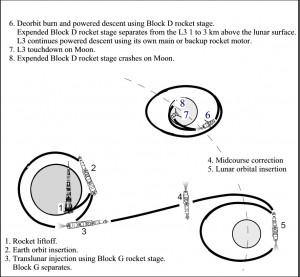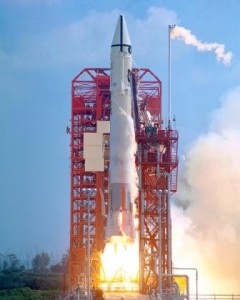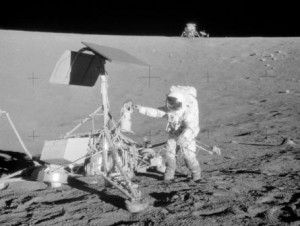Going to the Moon!
Melbourne, Fl- Jul 2009  Robots, rovers, and landers went to the moon in the late 1960s and will start returning in numbers through the next 10 years. They will prepare the way for man’s return in the 2020s. Besides nations such as Russia, the United States, Japan, and India funding Lunar missions, there are several private enterprises seeking to land a rover on the moon. You have to get to the moon to do business there.
Robots, rovers, and landers went to the moon in the late 1960s and will start returning in numbers through the next 10 years. They will prepare the way for man’s return in the 2020s. Besides nations such as Russia, the United States, Japan, and India funding Lunar missions, there are several private enterprises seeking to land a rover on the moon. You have to get to the moon to do business there.
We have several methods to reach the moon, with the differences being in how much energy you can afford. On one extreme, brute force will get you to the moon in about a day and a half. The former Soviet Union had this capability. On the other end, the journey could take over a year by using the attractive pull of celestial bodies. This is very efficient but tricky to get exactly right, and risky because the time in space is long. We will explain a less risky and more moderate energy model to reach the moon. This was the method used for the US moon landings.
Going to the moon is an interesting problem in hitting a moving target. First your lift rocket with payload leaves Earth and then orbits until it is at the right time and place. When you are ready to send it off to the moon, you fire your lunar rocket and leave your lift rocket behind to eventually reenter the atmosphere and burn up. You have now entered the Translunar phase of the journey. See figure 1, steps 1, 2. and 3.

Figure 1
8 steps to reach the moon
(figure 1 adapted from http://commons.wikimedia.org/wiki/File:Mir-14.jpg)
When we are about half way to the moon, you fire little rockets to correct our course so that we enter an orbit around the moon. See figure 1, steps 4 & 5
At just the right time and place we need to turn around and fire the rocket again to slow our speed enough to cause us to spiral down to the moon’s surface. At about 3 kilometers (1.86 miles) above the moon you discard the spent rocket so it will not be in the way of your landing rocket. The spent rocket will crash into the moon, harmlessly we hope. See figure 1, steps 6, 7, & 8.
When about 2 kilometers (1.24 miles) from the moon’s surface you need to slow us down more to land, so you fire our landing rocket and control our descent until we softly touch down.

Figure 2
The Atlas-Centaur 10, shown in figure 2, carried the Surveyor 1 spacecraft. It lifted off from Pad 36A on May 30, 1966. The purpose of the Surveyor 1 mission was to scout the lunar surface for future Apollo manned lunar landing sites.
In figure 3, Conrad examines Surveyor III on November 20, 1969.

Figure 3
Our cross destined for the moon will ride on a robot inside a lunar Lander aboard a private lift vehicle. The robot will look entirely different from the Surveyor (above) because the robot will be a “Rover” , using wheels so it can roam around. TV cameras will transmit pictures to Earth, including pictures of the cross placed by the Rover.
All pictures referenced here are from the Wikimedia Commons. Commons is a freely licensed media file repository. For more info visit Wikipedia-Surveyor
Cross Exists in Whirlpool Galaxy
 This 1992 enhanced X-ray image of the core of the nearby spiral galaxy M51, taken with the Wide Field Planetary camera (in PC mode) on NASA’s Hubble Space Telescope, shows a striking , dark “X” silhouetted across the galaxy’s nucleus. The “X” is due to absorption by dust and marks the exact position of a black hole which may have a mass equivalent to one-million stars like the sun. The darkest bar may be an edge-on dust ring which is 100 light-years in diameter. The edge-on torus not only hides the black hole and accretion disk from being viewed directly from earth, but also determines the axis of a jet of high-speed plasma and confines radiation from the accretion disk to a pair of oppositely directed cones of light, which ionize gas caught in their beam. The second bar of the “X” could be a second disk seen edge on, or possibly rotating gas and dust in MS1 intersecting with the jets and ionization cones.
This 1992 enhanced X-ray image of the core of the nearby spiral galaxy M51, taken with the Wide Field Planetary camera (in PC mode) on NASA’s Hubble Space Telescope, shows a striking , dark “X” silhouetted across the galaxy’s nucleus. The “X” is due to absorption by dust and marks the exact position of a black hole which may have a mass equivalent to one-million stars like the sun. The darkest bar may be an edge-on dust ring which is 100 light-years in diameter. The edge-on torus not only hides the black hole and accretion disk from being viewed directly from earth, but also determines the axis of a jet of high-speed plasma and confines radiation from the accretion disk to a pair of oppositely directed cones of light, which ionize gas caught in their beam. The second bar of the “X” could be a second disk seen edge on, or possibly rotating gas and dust in MS1 intersecting with the jets and ionization cones.
The size of the image is 1100 light-years.
Magnificent Desolation

July 14, 2009 | By Rob Verger, Globe Correspondent
On July 20, 1969, Buzz Aldrin and Neil Armstrong became the first humans to set foot on the moon. Four days later, completing a journey of more than 800,000 miles, Aldrin, Armstrong, and Michael Collins splashed down in the Pacific. The world was different afterward, and so were the lives of the three men.
In a new memoir written with Ken Abraham, “Magnificent Desolation: The Long Journey Home From the Moon,’’ Aldrin, 79, discusses the moon landing and subsequent events. The thrust of the book is about his struggles with depression, as well as alcoholism and recovery. He’ll talk about those topics tonight at McLean Hospital’s annual dinner at Boston’s InterContinental Hotel, six days before the 40th anniversary of his moon walk.
The book’s title comes from a phrase Aldrin uttered while on the moon’s surface 40 years ago. First he had used the word “beautiful’’ to describe the moonscape, he explained in a phone interview. “Then I felt that’s not really right,’’ he said. “It’s magnificent, that we’re here, that humankind has culminated in being able to do this. But there isn’t a place on Earth that is more desolate than what we were looking at. No life whatsoever. There wasn’t any way to simulate the mono-color of the moon, and the black sky.’’
Aldrin earned a doctorate from MIT in 1963. Last month he performed, as a narrator, with the Boston Pops. Tonight he’ll receive the McLean Award, given “to honor individuals who have made great strides in raising awareness of psychiatric illness.’’
What advice might he have for others who are struggling with alcoholism or depression? “Well, I’ve elected to do that more by role model than by trying to have generalities of behavior, because my case is kind of unusual,’’ he said with a chuckle.
“The number one thing that you have to do is to recognize a problem, and that’s something that you have to do, and people on the outside can try and help you, and you build up defenses against that, and that’s called denial,’’ he added. “That’s why the first step is admit it to yourself that you needed help somewhere else.’’
But it’s hard to talk with Aldrin without wanting to know more about that seminal event four decades ago, when he saw the Earth from the moon. “
You know, you can be very esoteric, and describe the orb of blue and white and tanned, sitting there, majestically, in the black velvet background, and no stars to accompany it, and that’s a poet’s description, I guess,’’ he said. “But the spatial, astronomically-aware engineering operator is familiar with space and time, and we put that into perspective, and it sounds kinda boring, but yeah, there’s the Earth up there, and yes it is four times bigger than we would see the moon from the Earth, and yeah it’s got color to it. And oh yes, by the way, there’re about 6 billion people back there, and there are only three of us here.’’
© Copyright 2009 The New York Times Company Source here
